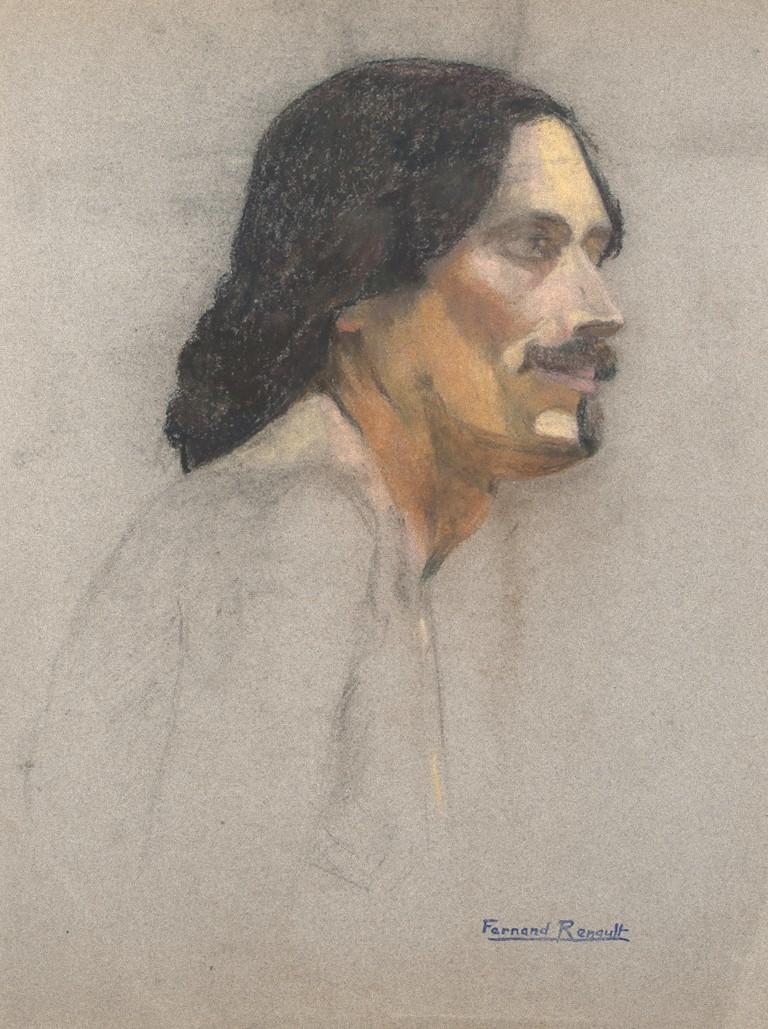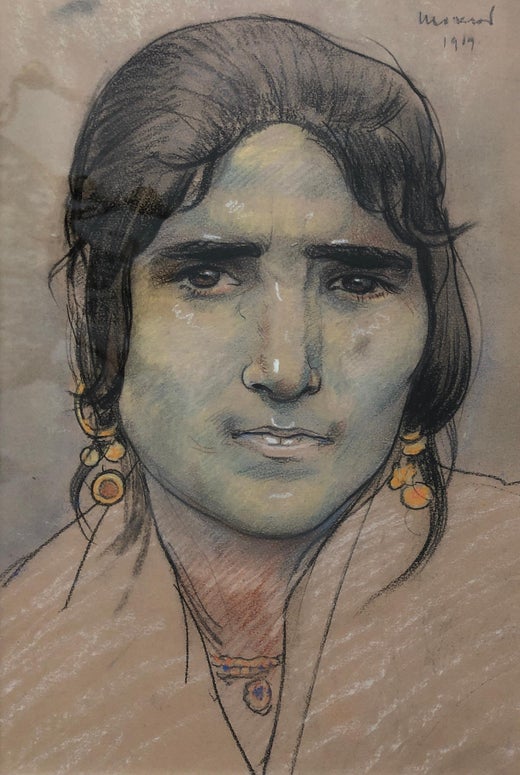Items Similar to Native American woman portrait
Want more images or videos?
Request additional images or videos from the seller
1 of 9
Édouard MorerodNative American woman portrait1919
1919
About the Item
Work on paper
Molded frame in gilded wood with glass pane
61 x 51 x 6.5 cm
- Creator:Édouard Morerod (1879 - 1919, Swiss)
- Creation Year:1919
- Dimensions:Height: 12.21 in (31 cm)Width: 7.88 in (20 cm)Depth: 0.12 in (3 mm)
- Medium:
- Period:
- Condition:Original frame.
- Gallery Location:Genève, CH
- Reference Number:1stDibs: LU2018210935592
Édouard Morerod
Édouard Henri Louis Morerod, born May 16, 1879 in Aigle and died July 22, 1919 in Lausanne, was a painter from Vaud. When his father died in 1889, the family moved to Lausanne, where the boy attended the Cantonal College. In 1891, when the mother died, Édouard and his sister were placed in a boarding school. The young man studied in Neuchâtel, at the Latin College, then at the cantonal gymnasium (from 1895), but passed his baccalaureate in Lausanne (1897). Demobilized from his military service (Bern) in 1899, Édouard Morerod began studying at the School of Fine Arts in Munich (January and February 1900 only), then left for Germany, Sweden and Norway. After a visit to Ibsen (in Oslo), he begins to write his diary. During a stay in Paris (1900), he met Steinlen, who would influence his work. In 1901, Édouard Morerod spent three months in Lotarevo (Russia), then discovered the country (Moscow, Tsaritzen, Georgia, Crimea). Before returning to Lausanne, where his first exhibition (Grenette) will be held, he stops in Constantinople, Athens and Rome. From 1903, Édouard Morerod stayed several times in Spain (Andalusia (Seville), Toledo). Success finally crowned his work: the Luxembourg Museum, the City of Paris and the Museum of Fine Arts in Neuchâtel sent him commissions. He exhibited at the Indépendants in 1903 and was a member of the jury for the Salon d'Automne in 1907. In Paris (1910), he met the Pulliéran painter Marius Borgeaud; he always meets Félix Vallotton, Alice Bailly and Francillon. Pierre Louÿs entrusts him with the artistic direction of his last play, La Femme et le Pantin, as well as the creation of the poster and the costumes (1910). After visits to several European cities, Édouard Morerod went to Leysin to treat himself from tuberculosis (1915), where he painted a few portraits. On December 6, 1915, his exhibition of pastels and drawings brought back from Spain opened in Lausanne, which Paul Vallotton presented in the salons of the Bernheim-Jeune gallery. While living surrounded by artists in Paris, the Beaux-Arts in Lausanne bought him a Pastora. In 1918, Édouard Morerod painted the sister of the poet Supervielle, Madame de Lasala. Édouard Morerod went to Seville in 1919, but his state of health forced him to return to Switzerland. After a brief stay in Leysin, he had to go back down to Lausanne, where he died on July 22, 1919. His body was buried in the Montoie cemetery. In 1921, the Galerie Moos in Geneva and the Musée Arlaud each devoted a retrospective to him.
About the Seller
5.0
Vetted Seller
These experienced sellers undergo a comprehensive evaluation by our team of in-house experts.
1stDibs seller since 2022
93 sales on 1stDibs
Typical response time: 3 hours
- ShippingRetrieving quote...Ships From: Genève, Switzerland
- Return PolicyThis item cannot be returned.
More From This SellerView All
- Portrait of young girlBy Henri FehrLocated in Genève, GEWork on paper Brown wooden frame with glass pane 48 x 39 x 1.5 cmCategory
Mid-20th Century Portrait Drawings and Watercolors
MaterialsPastel
- Pensive young girlBy Henri FehrLocated in Genève, GEWork on paper Golden wooden frame with glass pane 66 x 53.5 x 3.5 cmCategory
Mid-20th Century Portrait Drawings and Watercolors
MaterialsChalk, Pastel
- Portrait of Miss BachelardLocated in Genève, GEWork on paper Black wooden frame with glass pane 53 x 35 x 1.5 cmCategory
1930s Portrait Drawings and Watercolors
MaterialsPastel
- Young elegant woman in a hatBy Edgar ChahineLocated in Genève, GEWork on paper Brown wooden frame with glass pane 92 x 73 x 5 cmCategory
Early 20th Century French School Portrait Drawings and Watercolors
MaterialsChalk, Pastel
- View of the Môle and Mont-BlancLocated in Genève, GEWork on paper Golden wooden frame with glass pane 68 x 82.5 x 2.5 cmCategory
1960s Portrait Drawings and Watercolors
MaterialsCrayon
- BattleLocated in Genève, GEWork on paperCategory
1950s Portrait Drawings and Watercolors
MaterialsCrayon
You May Also Like
- MiguelBy Francine AuvrouinLocated in Paris, FRFusain et Pastel – 2013 - one of a kind drawing , large size.Category
21st Century and Contemporary Contemporary Figurative Drawings and Water...
MaterialsPastel, Charcoal
- Sans titre IBy Francine AuvrouinLocated in Paris, FRone of a kind drawing.Category
21st Century and Contemporary Contemporary Portrait Drawings and Waterco...
MaterialsPastel, Charcoal
- Young woman Drawing on paper 23x32 cmLocated in Geneva, CHWork on paper Monogram L.T.C.Category
Mid-20th Century Academic Portrait Drawings and Watercolors
MaterialsCharcoal, Pastel
- Portrait - Original Pastel and Charcoal by Fernand Renault - Early 20th CenturyBy Albert Fernand-RenaultLocated in Roma, ITPortrait is a beautiful drawing in pastel and charcoal on paper realized by Fernand Renault (1865-1909) In good condition. Stamped on the lower right. The artwork represents the p...Category
Early 20th Century Modern Figurative Drawings and Watercolors
MaterialsCharcoal, Pastel
- Hula Study, energetic realistic charcoal drawing on paper, girl and hula hoopBy Patsy McArthurLocated in Dallas, TX"Hula Study" is an energetic and unique charcoal on paper by Patsy McArthur showing a female figure dancing with a hula hoop. It is created using charcoal and pastel on pale pink Mur...Category
2010s Realist Figurative Drawings and Watercolors
MaterialsArchival Paper, Handmade Paper, Charcoal, Pastel
- Rare Modernist Hungarian Rabbi Pastel Drawing Gouache Painting Judaica Art DecoBy Hugó ScheiberLocated in Surfside, FLRabbi in the synagogue at prayer wearing tallit and tefillin. Hugó Scheiber (born 29 September 1873 in Budapest – died there 7 March 1950) was a Hungarian modernist painter. Hugo Scheiber was brought from Budapest to Vienna at the age of eight where his father worked as a sign painter for the Prater Theater. At fifteen, he returned with his family to Budapest and began working during the day to help support them and attending painting classes at the School of Design in the evening, where Henrik Papp was one of his teachers. He completed his studies in 1900. His work was at first in a post-Impressionistic style but from 1910 onward showed his increasing interest in German Expressionism and Futurism. This made it of little interest to the conservative Hungarian art establishment. However, in 1915 he met the great Italian avant-gardist Filippo Tommaso Marinetti and the two painters became close friends. Marinetti invited him to join the Futurist Movement. The uniquely modernist style that he developed was, however, closer to German Expressionism than to Futurism and eventually drifted toward an international art deco manner similar to Erté's. In 1919, he and his friend Béla Kádar held an exhibition at the Hevesy Salon in Vienna. It was a great success and at last caused the Budapest Art Museum to acquire some of Scheiber's drawings. Encouraged, Scheiber came back to live in Vienna in 1920. A turning point in Scheiber's career came a year later, when Herwarth Walden, founder of Germany's leading avant-garde periodical, Der Sturm, and of the Sturm Gallery in Berlin, became interested in Scheiber's work. Scheiber moved to Berlin in 1922, and his paintings soon appeared regularly in Walden's magazine and elsewhere. Exhibitions of his work followed in London, Rome, La Paz, and New York. Scheiber's move to Germany coincided with a significant exodus of Hungarian artists to Berlin, including Laszlo Moholy-Nagy and Sandor Bortnyik. There had been a major split in ideology among the Hungarian avant-garde. The Constructivist and leader of the Hungarian avantgarde, Lajos Kassák (painted by Hugó Scheiber in 1930) believed that art should relate to all the needs of contemporary humankind. Thus he refused to compromise the purity of his style to reflect the demands of either the ruling class or socialists and communists. The other camp believed that an artist should be a figurehead for social and political change. The fall out and factions that resulted from this politicisation resulted in most of the Hungarian avant gardists leaving Vienna for Berlin. Hungarian émigrés made up one of the largest minority groups in the German capital and the influx of their painters had a significant effect on Hungarian and international art. Another turning point of Scheiber's career came in 1926, with the New York exhibition of the Société Anonyme, organized by Katherine Dreier. Scheiber and other important avant garde artists from more than twenty-three countries were represented. In 1933, Scheiber was invited by Marinetti to participate in the great meeting of the Futurists held in Rome in late April 1933, Mostra Nazionale d’Arte Futurista where he was received with great enthusiasm. Gradually, the Hungarian artists began to return home, particularly with the rise of Nazism in Germany. Kádar went back from Berlin in about 1932 and Scheiber followed in 1934. He was then at the peak of his powers and had a special flair in depicting café and cabaret life in vivid colors, sturdily abstracted forms and spontaneous brush strokes. Scheiber depicted cosmopolitan modern life using stylized shapes and expressive colors. His preferred subjects were cabaret and street scenes, jazz musicians, flappers, and a series of self-portraits (usually with a cigar). his principal media being gouache and oil. He was a member of the prestigious New Society of Artists (KUT—Képzőművészek Új Társasága)and seems to have weathered Hungary's post–World War II transition to state-communism without difficulty. He continued to be well regarded, eventually even receiving the posthumous honor of having one of his images used for a Russian Soviet postage stamp (see image above). Hugó Scheiber died in Budapest in 1950. Paintings by Hugó Scheiber form part of permanent museum collections in Budapest (Hungarian National Museum), Pecs (Jannus Pannonius Museum), Vienna, New York, Bern and elsewhere. His work has also been shown in many important exhibitions, including: "The Nell Walden Collection," Kunsthaus Zürich (1945) "Collection of the Société Anonyme," Yale University Art Gallery, New Haven, Connecticut (1950) "Hugó Scheiber: A Commemorative Exhibition," Hungarian National Museum, Budapest (1964) "Ungarische Avantgarde," Galleria del Levante, Munich (1971) "Paris-Berlin 1900-1930," Centre Georges Pompidou, Paris (1978) "L’Art en Hongrie, 1905-1920," Musée d’Art et l’Industrie, Saint-Etienne (1980) "Ungarische Avantgarde in der Weimarer Republik," Marburg (1986) "Modernizmus," Eresz & Maklary Gallery, Budapest (2006) "Hugó Scheiber & Béla Kádár," Galerie le Minotaure, Paris and Tel Aviv (2007) Hugó Scheiber's paintings continue to be regularly sold at Sotheby's, Christie's, Gillen's Arts (London), Papillon Gallery (Los Angeles) and other auction houses. He was included in the exhibition The Art Of Modern Hungary 1931 and other exhibitions along with Vilmos Novak Aba, Count Julius Batthyany, Pal Bor, Bela Buky, Denes Csanky, Istvan Csok, Bela Czobel, Peter Di Gabor, Bela Ivanyi Grunwald, Baron Ferenc Hatvany, Lipot Herman, Odon Marffy, C. Pal Molnar...Category
Early 20th Century Modern Figurative Paintings
MaterialsPaper, Charcoal, Pastel, Watercolor, Gouache
Recently Viewed
View AllMore Ways To Browse
American Woman
Woman Portrait
Native American Painting
Portrait Woman On Paper
Framed Native American
Antique Woman Portrait
Antique Native American
Native American Antique
1919 Portrait
Woman Charcoal
Gilded Portrait
American Gilded Frame
Native Woman
Native American Portrait Paintings
Antique Glass Panes
Antique Glass Pane
Native American Woman
Woman Portrait Glass




